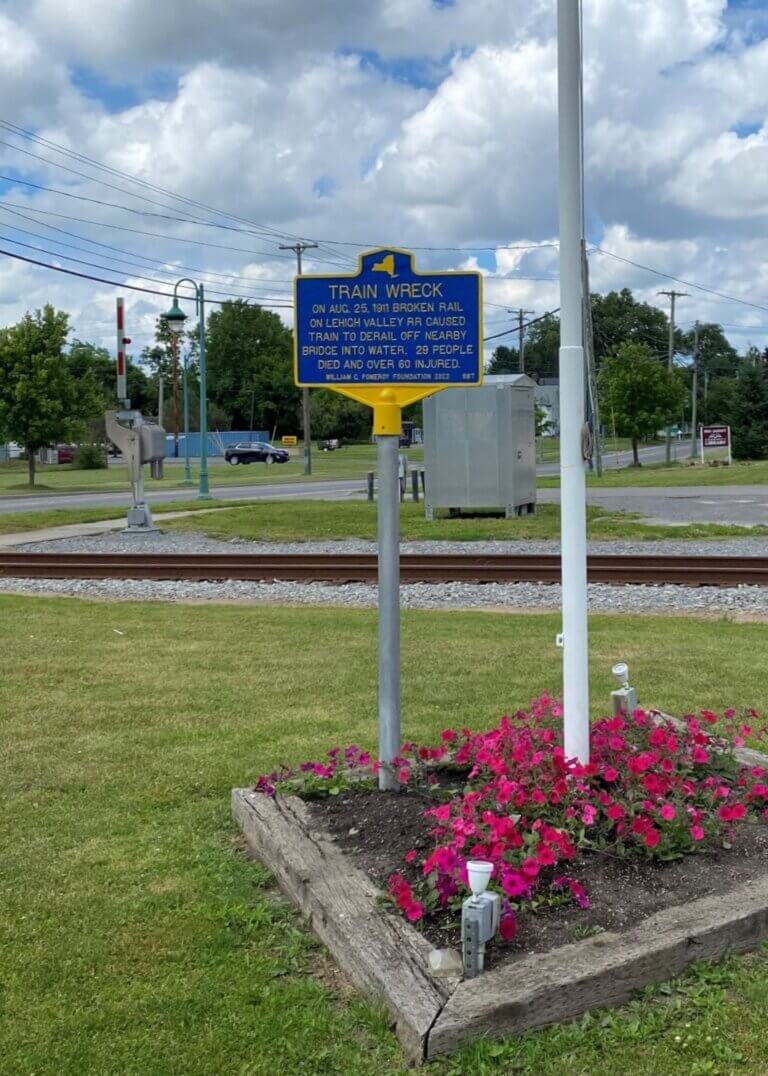TRAIN WRECK
- Program
- Subject
- Location
- Lat/Long
- Grant Recipient
-
NYS Historic
-
Event, Site, Transportation
- 103 S Main St, Manchester, NY 14504, USA
- 42.962446, -77.2297482
-
Village of Manchester New York
TRAIN WRECK
Inscription
TRAIN WRECKON AUG. 25, 1911 BROKEN RAIL
ON LEHIGH VALLEY RR CAUSED
TRAIN TO DERAIL OFF NEARBY
BRIDGE INTO WATER. 29 PEOPLE
DIED AND OVER 60 INJURED.
WILLIAM G. POMEROY FOUNDATION 2022
The train wreck that happened on August, 25th 1911 ranks as one of the worst tragedies to occur in Ontario County. When the dust settled, 29 people lost their lives and over 60 more were injured in an accident caused by a defective rail on the Lehigh Valley Railroad. At the time the train derailed it was in the process of passing a bridge over the Canandaigua outlet near Manchester, which led to several cars tumbling from the tracks into the water below.
In a report to the Interstate Commerce Commission made by the Chief Inspector of Safety Appliances on November 10th, 1911, the information below was recorded:
“The train was derailed by a broken rail, 247 feet west of a steel girder deck bridge spanning Canandaigua Outlet, causing the death of 27 passengers and 1 employee, and injuries to 59 passengers and 4 employees. One of the injured passenger died afterwards, making a total of 29 persons killed and 62 injured.”
The scene of the grisly wreck was soon swarming with those hoping to help the injured and locate the deceased. Newspaper reports from the time describe a chaotic scene, and in the aftermath the overwhelming question that arose was whether or not the accident might have been prevented. Case in point: in an article published in The Buffalo Enquirer the day after the accident the following passage was included.
“That the wreck was caused by a defective rail is admitted by all and efforts will now be made to find who is responsible for the dangerous condition of the track. Railroad officials insist that the flaw in the rail was only such as will always come unexpectedly in steel, but several survivors of the wreck insist that the crack in the steel was an old one and filled with rust.”
So whose fault was it? Based on the safety report made by the Chief Inspector, following the accident the rail at fault was found broken into seventeen pieces with a part of it never located, the rupture was caused primarily by “transverse fissures” throughout the rail, with a second cause of the piping within rail. The report goes on to state:
“The defects existing in the rail that caused this accident, both piping and fissures, were of such a nature that once the rail was placed in the track, careful inspection would fail to disclose them… With this information at present available, it is extremely difficult to suggest any preventative of future accidents of this character.”
Though the railroad inspectors were spared blame, the impact of the tragedy was felt across the state. The accident sent shockwaves through the Ontario County community as it sought to address the tragedy, while those killed in the accident came from all over.
This marker sites within 500 feet of the site of where the wreck occurred, and where previously a Lehigh Valley Railroad station stood. Now the space is used as the Manchester Railroad Park, where visitors can see several refurbished Lehigh Valley Railroad boxcars and a caboose.


